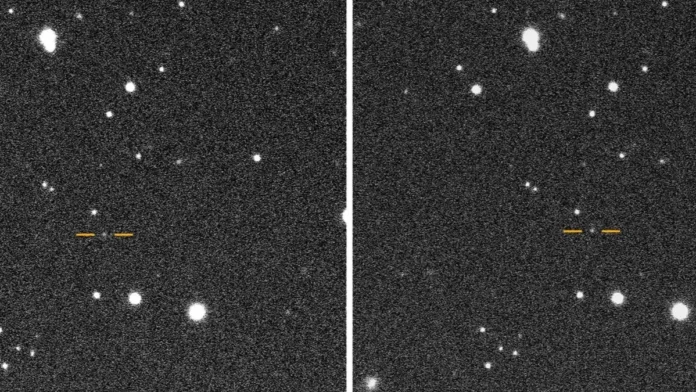
What Matters Now
• The extraordinary discovery of the “twilight” asteroid 2025 SC79, detected by the Dark Energy Camera, highlights how objects lurking near the Sun can elude Earth-based telescopes and may pose hidden risks.
• At the same time, the interstellar object 3I/ATLAS is traversing our inner solar system on a hyperbolic path and is now also positioned behind the Sun from Earth’s viewpoint. National Geographic
• The coincidence of both objects being hidden behind the Sun at roughly the same time raises the provocative question: is this a simple alignment, or could there be an underlying cosmic conjunction at work?
By Samuel Lopez | USA Herald
USA HERALD – In recent weeks astronomers announced the discovery of an impressive new asteroid, designated 2025 SC79, which completes a full orbit around the Sun in just 128 days, making it one of the fastest asteroids known to science. Detected on September 27 by Scott S. Sheppard of the Carnegie Institution for Science using the Dark Energy Camera mounted on the NSF’s Blanco 4-metre telescope, it was found lurking in the Sun’s glare — a challenging observational environment. Carnegie Science
2025 SC79 is estimated to be about 700 metres (≈2,300 ft) across. Its orbit lies mostly inside the orbit of Venus and at times crosses the orbit of Mercury, placing it in an extremely rare class of near-Sun asteroids often referred to as “twilight” objects because they can only be seen during the brief twilight window before sunrise or after sunset.
The challenging nature of its detection is emphasized by Sheppard’s own comments: “The most dangerous asteroids are the most difficult to detect… Asteroids that lurk near the Sun can only be observed during twilight.” Right now, 2025 SC79 has moved behind the Sun, from our vantage point on Earth, and will remain unobservable for several months.
At the same time, the solar system is host to an interstellar visitor: 3I/ATLAS (also designated C/2025 N1). This object arrived from outside the Solar System and is only the third confirmed interstellar object ever observed. It was discovered on July 1, 2025 by the ATLAS survey at Chile’s El Sauce observatory.
3I/ATLAS is on a hyperbolic trajectory, meaning it is not gravitationally bound to our Sun and will eventually depart the Solar System. It exhibits cometary activity and is of strong scientific interest because it offers a rare opportunity to study materials from outside the Solar System. Scientific American
According to current orbital data, 3I/ATLAS will reach its closest approach to the Sun (perihelion) at about 1.4 astronomical units, just inside Mars’ orbit, around 29 October 2025. From Earth’s perspective, the object is now hidden behind the Sun, rendering direct ground-based observation impossible until it emerges on the other side.
The simultaneous fact that 2025 SC79 and 3I/ATLAS are both hidden behind the Sun raises intriguing questions — coincidence or something more? For 2025 SC79 the inner-solar-system orbit is a consequence of orbital evolution and perturbations; for 3I/ATLAS its interstellar origin and hyperbolic escape path are clearly documented. There is no current evidence of an engineered conjunction, yet the timing and geometry prompt deeper reflection on observational blind spots.
From a planetary-defense standpoint this is a reminder of the hidden terrain of near-Sun space. Astronomers emphasize that many asteroids could be lurking in the glare of our star, unseen and untracked, until they suddenly become visible or, worse, approach from directions difficult to monitor. 2025 SC79 serves as a striking example of how objects inside Venus’ orbit can slip under the radar.
In the case of 3I/ATLAS, the object poses no threat to Earth — its closest approach will still be about 1.8 AU (approximately 170 million miles) away from Earth. What we learn from it, however, may be deeply meaningful: its composition, travel history and origin may teach us about processes in other star systems and how small bodies populate interstellar space.
The questions now include: How did 2025 SC79 end up in such a tight orbit so close to the Sun? What is its composition and how is it surviving intense solar heating? And when these two objects emerge from behind the Sun, could coordinated observations offer new insight into near-Sun dynamics or interstellar object behavior?
Researchers are preparing for follow-up observations once 2025 SC79 exits its solar behind-Sun phase and becomes visible again. Meanwhile, space-based platforms and solar-conjunction tolerant instruments may offer glimpses of 3I/ATLAS’s continued journey.
For our readers at USA Herald, the takeaway is two-fold: we must expand our watchful astronomy in the twilight zone near the Sun where hidden threats may hide; and we must also seize the rare windows offered by interstellar visitors, which open new chapters in our understanding of the cosmos.
As always, stay tuned for updates — when these objects return from behind the Sun, the observational opportunities may be brief but scientifically rich.


